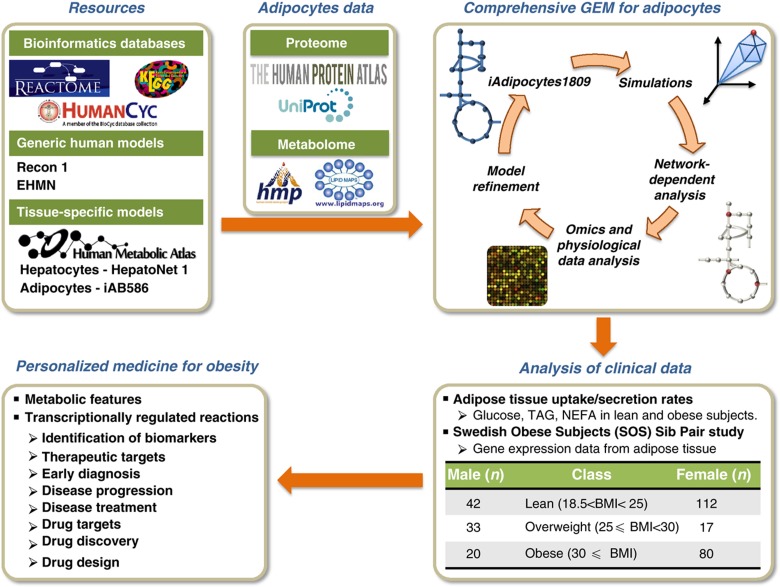Figure 1.
Genome-scale metabolic models (GEMs) provide a scaffold for integrative analysis of clinical data. Schematic illustration of how a comprehensive and functional GEM for adipocytes may provide links between specific molecular processes and subject phenotypes and hereby contribute to the development of personalized medicine for obesity. Here, the GEM iAdipocytes1809 was reconstructed to bridge the gap between genotype and phenotype through the use of proteome, metabolome, lipidome and transcriptome data, literature-based models (Recon 1, Edinburg Human Metabolic Network (EHMN) and HepatoNet1) and public resources (Reactome, HumanCyc, KEGG and the Human Metabolic Atlas). We first performed global protein profiling of adipocytes encoded by 14 077 genes to study adipocyte biology at the genome-wide level using antibodies generated within the Human Protein Atlas (HPA). We further used information on metabolome and lipidome data from the Human Metabolome Database (HMDB) and LIPID MAPS Lipidomics Gateway, respectively. Model driven simulations, network-dependent analysis and condition-specific transcriptome data allowed for model refinement. iAdipocytes1809 was used for the analysis of gene expression data obtained from subjects with different body mass indexes in the Swedish Obese Subjects (SOS) Sib Pair study and other adipose tissue relevant clinical data such as uptake/secretion rates in lean and obese subjects. Employing iAdipocytes1809 for integration of transcriptome and fluxome enables understanding of adipocyte metabolism in obese subjects compared with lean subjects. Furthermore, the results of the study lead to identification of molecular mechanisms underlying obesity and its adverse outcomes. This can be useful for identification of new therapeutic and drug targets and discovery of new biomarkers for predicting prognosis and outcome of the disease, developing a system-oriented drug design strategy, obtaining novel diagnostic and therapeutic techniques and eventually determining effective personalized medicines for treatment of obesity-related diseases.

